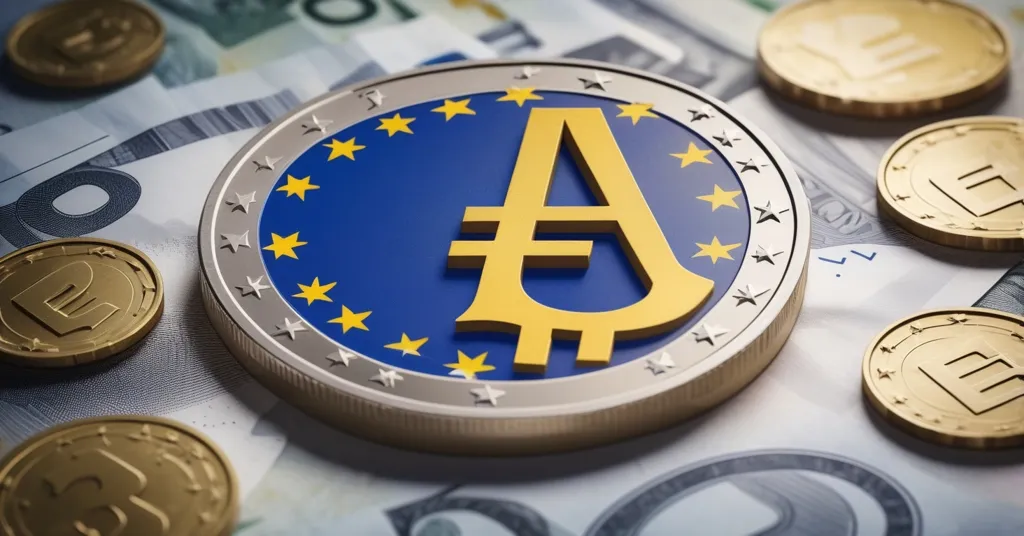ECB’s Digital Euro: Preserving Cash in the Digital Age with DLT and Privacy Focus

ECB Pushes for Digital Euro to Maintain Cash’s Relevance in Digital Age
- ECB aims to preserve cash’s role with digital euro
- Two-thirds of euro area card payments handled by non-European firms
- Digital euro to offer offline functionality and privacy
- ECB explores DLT and tokenization for wholesale transactions
The European Central Bank (ECB) is taking bold steps to ensure cash remains a viable option in an increasingly digital world. ECB Executive Board Member Piero Cipollone has stressed the urgency of introducing a digital euro, highlighting the decline in physical cash usage and Europe’s heavy reliance on non-European payment service providers.
In a world where digital giants like Apple Pay and Alipay dominate the payment landscape, the ECB sees the digital euro as a crucial tool to maintain strategic autonomy and monetary sovereignty. Cipollone pointed out that a staggering two-thirds of card payments in the euro area are processed by non-European firms, and 13 euro area countries rely entirely on international card schemes or mobile platforms for point-of-sale transactions. This dependency not only highlights a competitiveness and innovation gap but also threatens the user experience across the euro area.
The digital euro is proposed as a complement to cash, not a replacement. It would be legal tender, offering offline functionality to provide the privacy and usability akin to physical cash. This move aims to bridge the competitiveness and innovation gap and enhance the user experience across the euro area. Imagine trying to buy a croissant with a digital euro while standing in line at a Parisian café. It’s like trying to pay with a hologram, but with the convenience of cash!
The trend towards digital payments was further underscored by PayPal’s recent announcement to accept contactless payments in Germany using Mastercard technology. Cipollone noted, “PayPal said that it will begin to accept contactless payments in Germany, with Mastercard technology.” This development highlights the need for a European digital payment solution to maintain control over the continent’s financial infrastructure.
Surveys conducted by the ECB reveal a growing public interest in the digital euro, with nearly half of respondents expressing a likelihood to use it. This enthusiasm is mirrored by the involvement of around 70 merchants, fintech companies, startups, banks, and other payment service providers in the ECB’s innovation partnerships. These collaborations are crucial for exploring the potential of the digital euro and ensuring it meets the needs of users across the euro area.
Beyond retail payments, the ECB is also venturing into the realm of distributed ledger technology (DLT) and tokenization for wholesale financial transactions. Over 60% of European banks are either considering or already using DLT, with 22% having DLT applications in place. DLT is essentially a secure way of recording transactions and data across multiple devices, while tokenization involves converting rights to an asset into a digital form. The ECB plans to provide a facility to settle DLT transactions using central bank money in the near future, aiming to integrate these new technologies with traditional monetary systems and prevent the dominance of alternative settlement assets like stablecoins.
The ECB’s push towards a digital euro and the exploration of DLT and tokenization reflect their commitment to maintaining cash’s central role in the digital economy while fostering innovation and ensuring financial stability. As the digital landscape continues to evolve, the ECB’s initiatives could play a pivotal role in shaping the future of payments in Europe.
While the digital euro promises to enhance Europe’s strategic autonomy and bridge the innovation gap, it’s not without its critics. Some argue that a digital euro could be a tool for government surveillance, turning every transaction into a traceable event. Others worry about the potential for increased control over personal finances. These concerns highlight the importance of balancing innovation with privacy and freedom, values that are at the core of the cryptocurrency movement.
In the broader context of cryptocurrencies and blockchain technology, the digital euro represents a significant step towards a more digital financial future. While it may not disrupt the status quo in the same way as Bitcoin, it could serve as a stepping stone for further adoption of decentralized technologies. The digital euro’s focus on offline functionality and privacy aligns with the principles of decentralization and freedom that drive the crypto community, even if it is a centralized initiative.
Key Takeaways and Questions
- What is the purpose of the digital euro according to the ECB?
The purpose of the digital euro, as stated by the ECB, is to preserve the central role of cash in the digital economy by providing a digital counterpart that complements physical cash.
- How does the ECB plan to address the dependency on non-European payment service providers?
The ECB aims to enhance strategic autonomy by introducing the digital euro, which would be a European-based digital payment solution, reducing reliance on foreign payment providers.
- What are the core challenges facing European payments according to the ECB?
The core challenges are strategic autonomy and monetary sovereignty, bridging the competitiveness and innovation gap, and enhancing a dispersed user experience for Europeans.
- What features will the digital euro have?
The digital euro will be legal tender, offer offline functionality for privacy and usability similar to cash, and be free for basic use, covering all payment needs throughout the euro area.
- How is the ECB involving private sector partners in the development of the digital euro?
The ECB is collaborating with approximately 70 merchants, fintech companies, startups, banks, and other payment service providers through innovation partnerships to explore the digital euro’s potential.
- What role does DLT and tokenization play in the ECB’s plans?
The ECB is advancing the use of DLT and tokenization for wholesale financial transactions, aiming to integrate central bank money into these technologies to facilitate efficient trading, settlement, and custody on a single platform.
- What is the ECB’s stance on stablecoins and other alternative settlement assets?
The ECB aims to prevent the dominance of alternative settlement assets like stablecoins by providing central bank money for DLT transactions, ensuring that these new technologies are integrated with traditional monetary systems.
- Will the digital euro be secure?
The ECB has emphasized that the digital euro will be secure, with measures in place to protect user data and transactions, similar to the security provided by traditional banking systems.
- How will the digital euro affect privacy?
The digital euro promises to offer privacy through offline functionality, allowing users to make transactions without an internet connection, similar to using cash. However, concerns remain about potential government surveillance and control over personal finances.
- How does the digital euro fit into the broader context of cryptocurrencies and blockchain technology?
The digital euro represents a step towards a more digital financial future, aligning with the principles of decentralization and freedom in the crypto community. While it is a centralized initiative, it could pave the way for further adoption of decentralized technologies.



